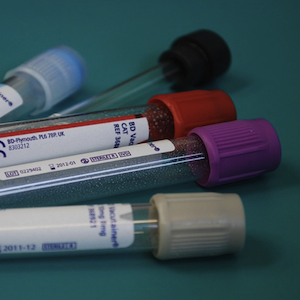Evaluation of Coaguchek®Pro II coagulation testing device performance to assess direct oral anticoagulant action. The DOAC-CHECK study

Submitted: 8 July 2022
Accepted: 3 November 2022
Published: 1 December 2022
Accepted: 3 November 2022
Abstract Views: 1401
PDF: 281
Publisher's note
All claims expressed in this article are solely those of the authors and do not necessarily represent those of their affiliated organizations, or those of the publisher, the editors and the reviewers. Any product that may be evaluated in this article or claim that may be made by its manufacturer is not guaranteed or endorsed by the publisher.
All claims expressed in this article are solely those of the authors and do not necessarily represent those of their affiliated organizations, or those of the publisher, the editors and the reviewers. Any product that may be evaluated in this article or claim that may be made by its manufacturer is not guaranteed or endorsed by the publisher.
Most read articles by the same author(s)
- Daniela Poli, Emilia Antonucci, Gualtiero Palareti, Roberto Facchinetti, Pietro Falco, Giuseppina Serricchio, Teresa Lerede, Lucilla Masciocco, Paolo Gresele, Sophie Testa, Major bleedings in mechanical prosthetic heart valves patients on Vitamin K antagonist treatment. Data from the PLECTRUM Study , Bleeding, Thrombosis and Vascular Biology: Vol. 1 No. 2 (2022)
- Daniela Poli, Walter Ageno, Emilia Antonucci, Salvatore Bradamante, Eugenio Bucherini, Paolo Chiarugi, Antonio Chistolini, Benilde Cosmi, Anna Falanga, Antonio Insana, Domenico Lione, Rosa Maria Lombardi, Giuseppe Malcangi, Rossella Marcucci, Giuliana Martini, Lucilla Masciocco, Carmelo Paparo, Daniele Pastori, Simona Pedrini, Vittorio Pengo, Pasquale Pignatelli, Andrea Toma, Sophie Testa, Gualtiero Palareti, Management of anticoagulation in atrial fibrillation patients in Italy: insight from the Atrial Fibrillation-Survey on Anticoagulated Patients Register (AF-START) , Bleeding, Thrombosis and Vascular Biology: Vol. 2 No. 2 (2023)
- Gualtiero Palareti, Paolo Prandoni, Cristina Legnani, Emilia Antonucci, Serena Zorzi, Alberto Tosetto, Lorenza Bertù, Sophie Testa, Vittorio Pengo, Walter Ageno, Ida Martinelli, Benilde Cosmi, Eugenio Bucherini, Daniela Poli, Rationale and design of a study on D-dimer use to stratify patients after a first unprovoked venous thromboembolism for their risk of recurrence: extended low-dose Apixaban given only to patients with positive D-dimer results , Bleeding, Thrombosis and Vascular Biology: Vol. 1 No. 1 (2022)
- Gualtiero Palareti, The diagnostic procedure for subjects with suspected pulmonary embolism. A recent comparison among the recommendations available from the international guidelines , Bleeding, Thrombosis and Vascular Biology: Vol. 3 No. 1 (2024)
- Vittorio Pengo, Luca Sarti, Emilia Antonucci, Stefania Di Agostino, Elisa Bison, Gentian Denas, Daniela Poli, Pier Luigi Meroni, Roberto Gerli, Antonella Radice, Gualtiero Palareti, on behalf of FIRMA group and START collaborators, Descriptive analysis of patients positive for anti-phospholipid antibodies included in two Italian registries , Bleeding, Thrombosis and Vascular Biology: Vol. 2 No. 3 (2023)
- Gianfranco De Girolamo, Luca Sarti, Sonia Cecoli, Karin Bonora, Chiara Ajolfi, Francesco Bellelli, Valeria Coluccio, Gualtiero Palareti, Marco Marietta, Safety and efficacy of treatment with vitamin K antagonists in patients managed in a network of anticoagulation services or as routine general care , Bleeding, Thrombosis and Vascular Biology: Vol. 1 No. 1 (2022)
- Daniela Poli, Riccardo Tartaglia, Doris Barcellona , Paolo Bucciarelli , Antonio Ciampa, Elvira Grandone, Giuseppe Malcangi, Giuseppe Rescigno, Vincenzo Toschi, Sophie Testa, Alessandro Squizzato, Attitude to clinical research among health professionals affiliated with the Italian Federation of Centers for the Diagnosis of Thrombotic Disorders and the Surveillance of the Antithrombotic Therapies (FCSA) , Bleeding, Thrombosis and Vascular Biology: Vol. 2 No. 1 (2023)
- Gualtiero Palareti, Management of atrial fibrillation: a practical and useful synopsis of last guidelines , Bleeding, Thrombosis and Vascular Biology: Vol. 4 No. 1 (2025)
- Ilaria Nichele, Giuseppe Carli, Alberto Tosetto, Tailored therapy with turoctocog alfa pegol according to patient’s lifestyle and hemorrhagic phenotype: from clinical trial to real-life , Bleeding, Thrombosis and Vascular Biology: Vol. 3 No. 1 (2024)
Similar Articles
- Rossana Corso, Andrea Coppola, Stefano Grazioli, Cristina Dedionigi, Nicolò Tandurella, Massimo Venturini, Francesco Dentali, Iatrogenic pseudoaneurysm of inferior epigastric artery: not only a surgical complication , Bleeding, Thrombosis and Vascular Biology: Vol. 1 No. 2 (2022)
- Robert Parambi, Nicole Ziliotto, Francesco Bernardi , Marcello Baroni , Richard W Browne , Dejan Jakimovski, Bianca Weinstock-Guttman, Robert Zivadinov, Murali Ramanathan, Crosstalk between hemostasis inhibitors and cholesterol biomarkers in multiple sclerosis , Bleeding, Thrombosis and Vascular Biology: Vol. 1 No. 3 (2022)
- Rosina Albisinni, Tommaso Marrazzo, Arta Karruli, Sabrina Manduca, Giuseppe Nobile, Nicola Galdieri, Marisa De Feo, Successful treatment of aortic arch mural thrombosis with low-dose, ultra-slow-flow thrombolysis: a case report and literature review , Bleeding, Thrombosis and Vascular Biology: Vol. 1 No. 3 (2022)
- Augusto Di Castelnuovo, Licia Iacoviello, Moving beyond p-value , Bleeding, Thrombosis and Vascular Biology: Vol. 1 No. 1 (2022)
- Pier Mannuccio Mannucci, Growing weapons to fight hemophilia , Bleeding, Thrombosis and Vascular Biology: Vol. 2 No. 1 (2023)
- Mosaad Almegren, Clinical and radiological characteristics of cerebral vein thrombosis: a retrospective study , Bleeding, Thrombosis and Vascular Biology: Vol. 2 No. 3 (2023)
- Kamran Abbasi, Parveen Ali, Virginia Barbour, Kirsten Bibbins-Domingo, Marcel G.M. Olde Rikkert, Andy Haines, Ira Helfand, Richard Horton, Bob Mash, Arun Mitra, Carlos Monteiro, Elena N. Naumova, Eric J. Rubin, Tilman Ruff, Peush Sahni, James Tumwine, Paul Yonga, Chris Zielinski, Reducing the risks of nuclear war - The role of health professionals , Bleeding, Thrombosis and Vascular Biology: Vol. 2 No. 3 (2023)
- Roberto Mario Santi, Annamaria Fulghesu, Ezio Zanon, Erica De Candia, Elvira Grandone, Giancarlo Di Renzo, Claudia Succu, Valentina Tosto, Vincenzina Bruni, Paolo Gresele, Diagnosis and management of abnormal uterine bleeding in adolescence , Bleeding, Thrombosis and Vascular Biology: Vol. 3 No. 1 (2024)
- Yishi Tan, Marc Carrier, Nicola Curry, Michael Desborough, Kathryn Musgrave, Marie Scully, Tzu-Fei Wang, Mari Thomas, Simon J. Stanworth, Cancer complicated by thrombosis and thrombocytopenia: still a therapeutic dilemma , Bleeding, Thrombosis and Vascular Biology: Vol. 3 No. s1 (2024): 12th ICTHIC
- Betül Ünlü, Neha Joshi, Jamie M. O'Sullivan, Endothelial cell dysfunction in cancer: a not-so-innocent bystander , Bleeding, Thrombosis and Vascular Biology: Vol. 3 No. s1 (2024): 12th ICTHIC
You may also start an advanced similarity search for this article.

 https://doi.org/10.4081/btvb.2022.37
https://doi.org/10.4081/btvb.2022.37










